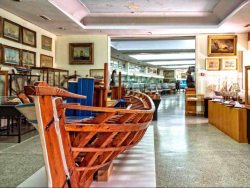Hellenic Maritime Museum

Hellenic Maritime Museum
The Hellenic Maritime Museum of Greece was provisionally housed in an old and small, 2-story building on Moutsopoulou Coast of Marina Zea in Piraeus. It is a horseshoe-shaped, 2-aisled area covering a single level. The inner aisle covers a total of 1,900 m2 and it is the main area hosting the museum facilities. The external aisle, where exhibits have also been placed outdoors, has the shape of a peristyle.
A short time later, in 1964, the Piraeus Port Authority (OLP) and later the National Tourist Organization (EOT) leased at a symbolic rate the plot of land where the museum is now located. The entrance incorporates part of Conon's walls which was created to protect the ancient harbor.
The objectives of the Hellenic Maritime Museum are the collection, maintenance, preservation and exhibition of all items of historical significance that were collected from the nation's naval battles as well as from other naval activity of the Greeks from ancient times until today.
The Ministry of Culture has commonly assigned to the Hellenic Maritime Museum the representation of Greece at relevant events abroad. Moreover, the museum also participates and organizes equivalent exhibitions.
Over the past 6 decades, donators to this national venue include the Ministry of National Defense (Navy General Staff), the Ministry of Mercantile Marine (Navy Retirement Fund) and the Ministry of Culture.
Several private individuals have also made significant contributions and their names are listed beside the exhibits they have donated.
Directly outside of the building there is a circular square where sculptures and principal displays can be viewed.
For example, visitors can see the turret of the submarine "Papanikolis" and anchors belonging to ships which participated in the naval battle of Navarino. During the summer season, numerous events take place in this area.









